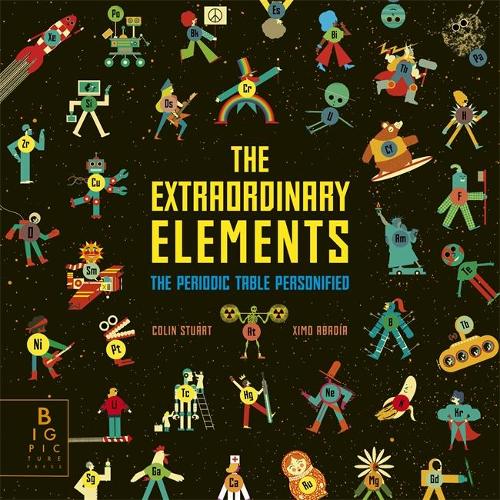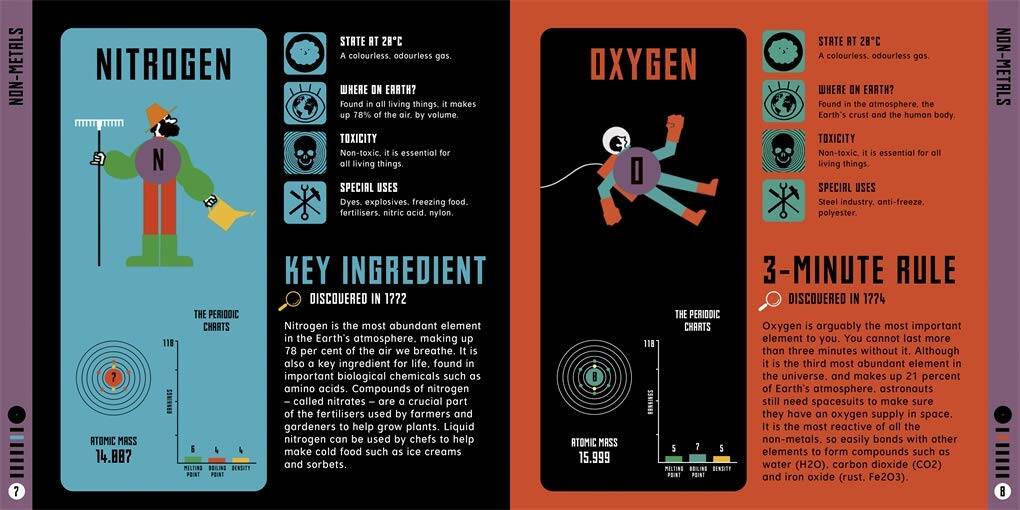The Extraordinary Elements by Colin Stuart – at a glance
The School Reading Lists’ five word review: Detailed, engrossing, memorable and fun.
Children’s book title: The Extraordinary Elements: The Periodic Table Personified.
Children’s author: Colin Stuart.
Genre: Children’s nonfiction.
Illustrated by: Ximo Abadía.
Published by Big Picture Press.
ISBN: 9781787417342
Recommended for children aged: 7-12.
First published: Hardback August 2020.
This children’s book is ideal for: children who are fascinated by science, facts, and detail.

To see the latest price or order, click on the book cover image. As an Amazon Associate schoolreadinglist.co.uk earns from qualifying purchases.
Our review:
The Extraordinary Elements is a beautifully presented small hardback for children aged 9 to 12. The cleverly designed pages introduce all the elements as fun cartoon characters with fact boxes and plenty of engaging data.
The book covers every known element in the periodic table from Hydrogen at number 1 to Hassium at 108, with the super heavy elements 109-118, and the mysterious elements 119 and 120 described at the back of the book. The history of elements is explored from prehistoric times through to the present day.
Atomic numbers are explained in terms of the number of protons in the nucleus and the mass number of each element. The book goes on to explore how different versions of the same elements can occur when extra neutrons are added, for example, Helium.
And it’s not just the Physics – there’s a Chemistry 101 section where ionic bonding, covalency, and chemical reactions are introduced carefully in a way that would be perfect for both pupils struggling in KS3 and KS4 and also children who need stretching in year six.
Then the real fun begins. The next 108 pages advertise each element as a character, helping children to understand the characteristics and properties of that element.
For example, Ruthenium is presented as a Russian doll, sourced from the Ural Mountains, and with a name derived from the Latin word Ruthenia meaning Russia. Sulphur is presented as a merlin type magician, popular with alchemists in the Middle Ages. Mercury appears with a striking resemblance to the lead singer of Queen and I’d swear Moscovium (Mc 115) was Lemmy from Motorhead. Clearly this book will also appeal to teachers of a certain age.
The consistent, colourful and fun layout of each element is what makes this book a winner. Part top trumps, part history, and part cartoon-like illustration, each elemental entry gives the junior age child in KS2 everything they need to know in terms of the physics and chemistry. Fact boxes detail at what temperature the element exists, where on the planet it can be found, and whether or not it’s dangerous. There is also a diagram showing the electron configuration, the melting point and boiling point, the density, and the atomic mass of the element. Importantly, each entry also examines how we use that element in the real world.
At the end of the book, there’s an interesting section that shows how elements are relevant to human beings and everyday life. This includes an elemental Olympics ranking the most reactive, the lowest and highest boiling points, the most expensive the heaviest and lightest – a plethora of interesting information.
There’s also a history section to explain how and when an element was discovered, and by whom, and where it was first found. All in all, there’s a mass of thought-provoking and unusual snippets that are great for testing family members’ general knowledge.
Using The Extraordinary Elements in the classroom
-
- Literacy / English – using as an impetus to create alternative biographies of people, places, or things.
- Great for topic work in KS2 on themes of science, physics, chemistry, scientists or materials, and their properties.
- This book’s design could be replicated as a great format for science revision resources in KS3.
- There’s a glossary that lends itself to genre work in key stage two.
- An ideal addition to KS2 and lower KS3 libraries. Perfect for reluctant readers in KS3.
Our verdict
The Extraordinary Elements is perfect for children who like to accumulate a lot of facts and information. Written in a catchy and accessible style by Colin Stuart, a Fellow of the Royal Astronomical Society and a science writer for magazines and newspapers including New Scientist and BBC Focus, this is a book that doesn’t dumb down the science for junior age children. The physics here is sound and provides a fantastic bedrock of information to inspire children to read further. The nature of each element is explained concisely and clearly and in a way that will not only appeal to children, but instill a curiosity to find out more.
Many thanks to Big Picture Press for the review copy.
If you like this book you might also like The Language of the Universe: A Visual Exploration of Mathematics by Colin Stuart and Ximo Abadía, The Speed of Starlight: How Physics, Light and Sound Work by Colin Stuart and Ximo Abadía, Discover our Solar System by Colin Stuart and Charlie Brandon-King, and 101 Awesome Women Who Transformed Science by Claire Philip and Isabel Muñoz.
Why not have a look at our list of books for Key Stage 2 or our collection of magazine subscriptions for children?
Please respect copyright and don’t copy or reproduce our content. Sharing on social media or linking to our site’s pages is fine. Thanks.


